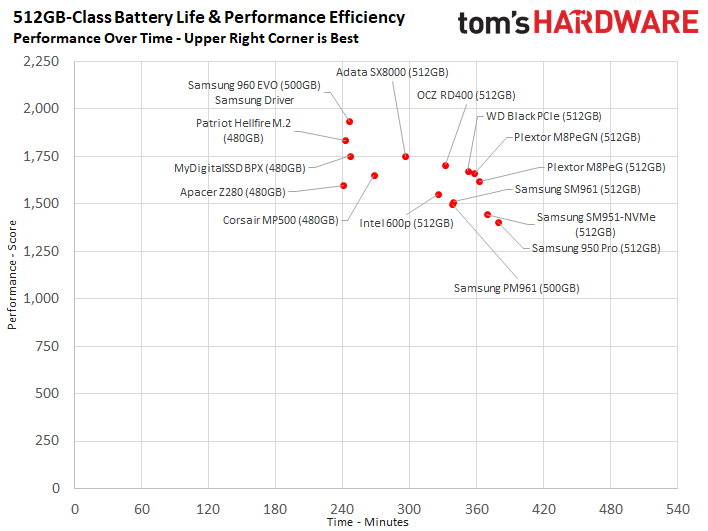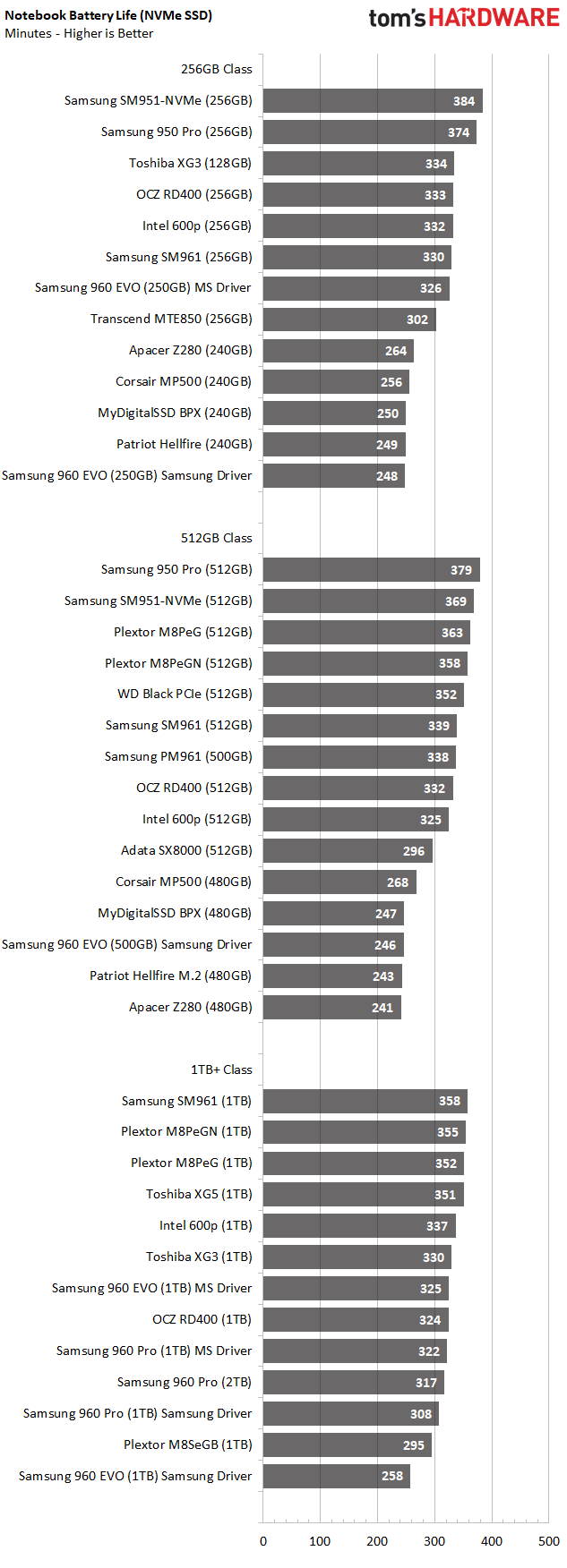Best Storage For Notebook Battery Life
NVMe SSD Results
NVMe (Non-Volatile Memory Express) is the future of storage. Intel started developing the protocol for next-generation 3D XPoint technology. For now, most NVMe devices use PCIe 3.0 with two or four lanes. We'll eventually see single-lane SSDs in low-cost notebooks.
These products do not use DEVSLP for the lowest power states. Instead, PCI-SIG developed a low power state called L1.2. Like DEVSLP in SATA storage devices, not every manufacturer dedicates resources to enabling the feature. We’ve seen some devices come to market without L1.2 but later gain the feature through a firmware update.
Unlike SATA, NVMe storage controllers can operate over custom drivers that add hidden functionality. The Microsoft driver built into Windows 8+ is a narrow range driver that provides the basic instruction set needed for all devices to work. Custom drivers let manufacturers add features through commands to the device. Every custom drive we’ve tested has reduced read latency, an area closely tied to the user experience. Every custom drive we’ve tested also reduces notebook battery life.
Notebook Battery Life
There is a 142 minute gap between the best and worst result in the NVMe SSD category. The Samsung SM951 series is an OEM model, and we’re not surprised to see it at the top of the chart. We used the Microsoft driver on the SM951 SSDs.
Peppered throughout the results you will see drives with a driver designation—either MS for Microsoft or a company name for the custom driver. The custom driver results are often found in the bottom half and the Microsoft driver test with the same product in the upper half.
Power Restricted Performance
The performance under reduced bus speed shows where all of the power goes when you load the custom driver. There is a very large gap, just as we saw in the previous chart, between the same devices running with and without the driver. We are most likely seeing a longer delay between the changes in power states.
There are several Phison PS5007-E7 devices in the top of the performance chart as well. It’s been reported that this controller doesn’t change power states, and in at least one firmware revision the power consumption actually increases when it should decrease.
Get Tom's Hardware's best news and in-depth reviews, straight to your inbox.



MORE: Best SSDs
MORE: How We Test HDDs And SSDs
MORE: All SSD Content

Chris Ramseyer was a senior contributing editor for Tom's Hardware. He tested and reviewed consumer storage.
-
WyomingKnott Thanks for this article. It's a question of great interest to all mobile warriors, and my assumption that NVMe would be best isn't correct overall.Reply -
DavidC1 Thanks for the review. We should see more reviews comparing SSD and HDD battery life, but reviewers just ASSUME SSDs will be better at it.Reply
Implementation details matter, and you can only see that by testing it.
Though I'm not a fan of using the Y700 for the test. The HQ chips do not have anywhere near the power management capability of the U chips. To be clear, its just about U series having lower TDP, but much lower idle as a platform.
I'm not sure whether such tests can be done reliably on a U platform as there may be drive specific optimizations done, and make the numbers irrelevant for actual products. But if its possible, U platforms would show greater differences in battery life between drives. -
CRamseyer You have to remember that we still have to meet deadlines (NDAs) with the reviews. I would need even more systems if testing on a U series processor or other system that gives users 10+ hours of battery life. It's still difficult to find systems that can use both M.2 NVMe and 2.5" SATA. At the end of the year I'll see what's available and most likely move away from a gaming platform. I expect these systems to stay in use until early 2019.Reply -
Lutfij I've been approached by a lot of folks regarding whether or not the addition of an SSD storage can and will improve battery life or the opposite. This article does bring some things into light! Thanks!Reply
I must also point out though that there are some among the community who are working with both a mechanical HDD and an SSD both in the 2.5" form factor so it'd be a nice write up to see if both drives running in the same laptop/mobile computing device takes a bigger hit in battery backup/performance.
To clear up, folks use an SSD caddy that does into a 9.5mm/12.7mm ODD slot on a laptop to re-purpose the SATA port for use with either an HDD or an SSD. -
mathew7 Or maybe, like my MSI laptop, shipped with an NVMe SDD and 2.5" HDD.Reply
I switched the HDD with the pretty-good scoring MX300 (thanks for confirming my good choice).
I also tried to replace the Toshiba NVMe with a M.2 SATA SM951 as the Toshiba would make a noticeable hotspot on the case. But it seems there are some mechanical issue with m.2 sata as flexing the case nearby would freeze the drive and touchpad until reboot.

